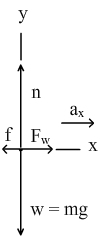|
| |
1-D equilibrium¡ªFigure 5.1
|
· Consider an athlete hanging on a massless rope.
|
|
|
| |
1-D equilibrium considering the rope¡ªFigure 5.2 |
· If we re-did the previous example in a less ideal world? The weight of the rope should be included.
|
· Refer to Example 5.2. |
|
| |
A crate on an inclined plane¡ªFigure 5.4 |
· An object on an inclined plane will have components of force in x and y space.
|
|
|
| |
Consider a mass on a plane tied to a cord over a pulley |
· You must draw two-free body diagrams.? The tension from the mass hanging is the same force that draws the cart up the ramp.
|
· Refer to Example 5.5. |
|
| |
Straight-line motion with constant force¡ªFigure 5.7 |
· Consider the sailboat mounted on an ice skate. |
|
|
| |
Consider motion against friction¡ªFigure 5.8 |
· Earlier, we considered the effect of using ¡°real¡± rope in a tension calculation.? How about friction at work in a problem that slides an object?
|
 |
|
| |
Calculation of tension in an elevator cable¡ªFigure 5.9 |
· The elevator mass is balanced by tension in the cable (that¡¯s why they have that ¡°maximum capacity¡± sign on the wall).
|
|
|
| |
More adventures in the elevator¡ªFigure 5.10 |
· The elevator allows riders to experience different weights (without dieting).
|
|
|
| |
Acceleration down a hill¡ªFigure 5.12 |
· If you grew up in the northeast, you could often ride on snow and ice in the winter using sleds. |
|
| |
Two bodies with the same magnitude of acceleration |
· A glider on the air track connected over a pulley (»¬ÂÖ) to a falling mass.
|
· Refer to Example 5.12 using Figure 5.15.
|
|
|
